July 29, 2010
Hymn to a Blue Hour
In March, I attended the CBDNA Southwestern Division conference in Las Cruces, New Mexico. I had a few fine performances there (Harvest — my new trombone concerto — with Texas Tech, and Kingfishers Catch Fire with the wind ensemble from Kansas State University), and spent a few days hanging out with fun people. And I also hung out with people who like to give me shit — particularly after a few drinks.
“Your music is all fast and loud,” I was told by a certain individual who shall remain nameless (Robert Carnochan). “Not just yours. Everybody is writing fast, loud music. But yours in particular. Fast and loud.”
“It’s true. You should write a slow, lyrical piece. If you did, I’d play it,” said another anonymous conductor (Steve Davis).
This wasn’t the only time I heard that this spring. A few days earlier, I’d been at the CBDNA Northeastern convention for the premiere of Harvest (shout-out to Joseph Alessi and the West Point Band), as well as a performance of “Asphalt Cocktail” with the West Chester University band (can I get a “what what” for Andrew Yozviak?). At the post-concert reception that followed West Chester’s concert, I was approached by none other than Donald Hunsberger, formerly the director of the Eastman Wind Ensemble, who said to me, “you know what I’d love to hear from you? A slow, lyrical, quiet piece.”
Sigh.
But it was really Rob Carnochan & Steve Davis, with their wine-enduced berating, that convinced me that yes, they were right. I write a lot of fast, loud music. But I write that music because I like that music. I write music that I want to hear. The beauty of writing for band is that if the piece is fairly successful, it’ll get a lot of performances, and I’ll hear a lot of performances. I’m not going to write a piece that I don’t want to sit through 50 times. If I’m going to write a piece, it’ll be a piece I want to listen to. I’m not writing a piece thinking, “oh, I hate this, but it’ll probably get played.” I’ve turned down commissions for works that I can’t imagine ever wanting to listen to. And my personal opinion is that a lot of slow lyrical stuff is cheesy and, the worst offense in life, boring.
But Rob and Steve got me thinking. What would happen if I sincerely tried to write a piece that was slow and songlike? Could I do that and not make it (gag) cheesy or (slamming my head into a wall just thinking about it) boring?
I guess I have a few (very few) instances in other band-based pieces that have accomplished this. The beginning of “Aurora Awakes” does this, but then it spends 75% of the piece very fast and rhythmic and dependent on the percussion section. The “Metal” movement of my Soprano Sax Concerto is probably my favorite slow music that I’ve written, but you need a superstar soprano sax player (yo, yo, Tim McAllister) to pull that off. Then there’s the slow movement of the trombone concerto, but unless you have Joe Alessi hanging around just hoping you’ll ask him to play the high D’s it requires, well, you’re SOL. And then there’s “Turning,” which never gets played (save for several performances from Kenneth Thompson, and an upcoming performance at Indiana with Jeffrey Gershman), possibly because it’s so dark, or because much of it is terribly dissonant, or maybe simply because it requires a $1000 waterphone. (I just posted a newly-discovered performance recording from Richard Clary at Florida State. If you haven’t heard Turning, with its unusual combination of angst and waterphone, give it a listen.)
So there’s stuff — it’s not like I’ve completely avoided slow music — but it’s not the norm, and what I didn’t have was a standalone, non-concerto work that’s simple, slow, and (hopefully) beautiful. So I gave it a shot.
What’s the best way to keep it simple? For me, the answer is: write it at the piano. I almost never write music “at the piano” because I don’t have any piano technique. I can find chords, but I play piano like a bad typist types: badly. But if I write the music using an instrument where I can barely get by, the result will be very different than if I sit at the computer and just throw a zillion notes at my sample library, all of which will be executed perfectly and at any dynamic level I ask. I decided to write this piece at the piano largely because we’re spending the summer at an apartment in New York that has a nice upright piano. I don’t have a piano at home — only a digital keyboard — and it’s very different to sit at a real piano with real pedals and a real action. It was fun. Now I want a piano.
Also fun: writing again in New York. This on its own is a very different experience, largely because of the requirement to walk everywhere here. If I want lunch, I’m walkin’. I get my best ideas when I’m just outside walking somewhere. No other US city requires you to walk to get where you want to go. If I’m in the car, I have music playing. Here, though, it’s just the sound (noise, I suppose) of the city. I wrote the main melody for the piece while sitting on a brownstone stoop one morning after picking up a cup of coffee. It was pretty funny, really, with me sitting outside on a beautiful summer morning in New York City, Moleskine music notebook in one hand, and my iPhone Pianist app in the other (so I could find pitches), writing this piece. As I said on Facebook, I felt like I was in an ad for something.
I’d been writing mostly at the piano and hadn’t put the piece into the computer yet to try orchestrating anything yet, and then, last Monday, I received my very fancy new toy: the Vienna Symphonic Library‘s “Complete Winds” sample collection. Once I had those samples — which are absolutely incredible, particularly the woodwinds — I started putting in 14 hour days. I finished the piece — in full score — yesterday.
And then there’s the title. I made an MP3 for AEJ, who comes up with almost all of my titles, and she listened to the piece a dozen times and gave me a list of possibilities. The final title is:
The “hymn” part of her title immediately made sense, as the melody is so simple that it does literally sound like a hymn. It’s one of those melodies that almost seems like it must already exist, and I kept wracking (or is it racking?) my brain trying to figure out if I’d actually written this tune, or if I’d accidentally stolen it. I’m now reasonably sure it’s an original tune.
What about the “blue hour” part? I hadn’t heard the term, but as AEJ told me (and the Wiki confirmed!), the “blue hour” is the period of twilight where there’s neither full daylight nor complete darkness. AEJ said that the piece sounds like vespers (the evening mass) at a simple Shaker church. Thus, “Hymn to a Blue Hour.” This is why she makes the big bucks.
“Hymn to a Blue Hour” was commissioned by Mesa State College. They’ll premiere the piece on December 3 at their Best of the West 2010 festival. The piece is dedicated to Stephen Boelter, who, with his wife Karen Combs, established the Best of the West festival.
The score is up now. The MIDI will follow… soon.
July 17, 2010
Blue Hill
We continue eating our way through New York with a visit to Blue Hill, a restaurant with a menu that “showcases local food,” with ingredients from “nearby farms, including Blue Hill Farm in Great Barrington, Massachusetts, and Stone Barns Center for Food and Agriculture, a forty-five minute drive from New York City.” As Frank Bruni described it in his review in 2006, it’s “food you’d almost rather hug than eat.” That’s accurate. This is food that celebrates the ingredients, not the preparation. Perhaps I’d have appreciated it more if we hadn’t had this 48 hours after our dinner at Eleven Madison Park, where every course was prepared with brilliant creativity. But back to Blue Hill…
The room itself is a few steps below street level in what used to be a speakeasy. It’s an intimate space, with low ceilings, and it’s dark. Dark, dark, dark. I’d have thought it cozy if I wasn’t trying to take pictures, but this level of light was a big challenge for my camera. I had to crank the ISO and the aperture in order to get anything, so the shots were noisy (thanks to the high ISO), and getting any consistent white balance, even with processing, was just about impossible. But that’s enough bitching about the light. There’s so much more to complain about.
After you’re seated, they bring you some bread. The bread was pretty good, but not memorable. I don’t believe it was warm, and it wasn’t sweet, or yeasty, or, well, much of anything. It was… fine.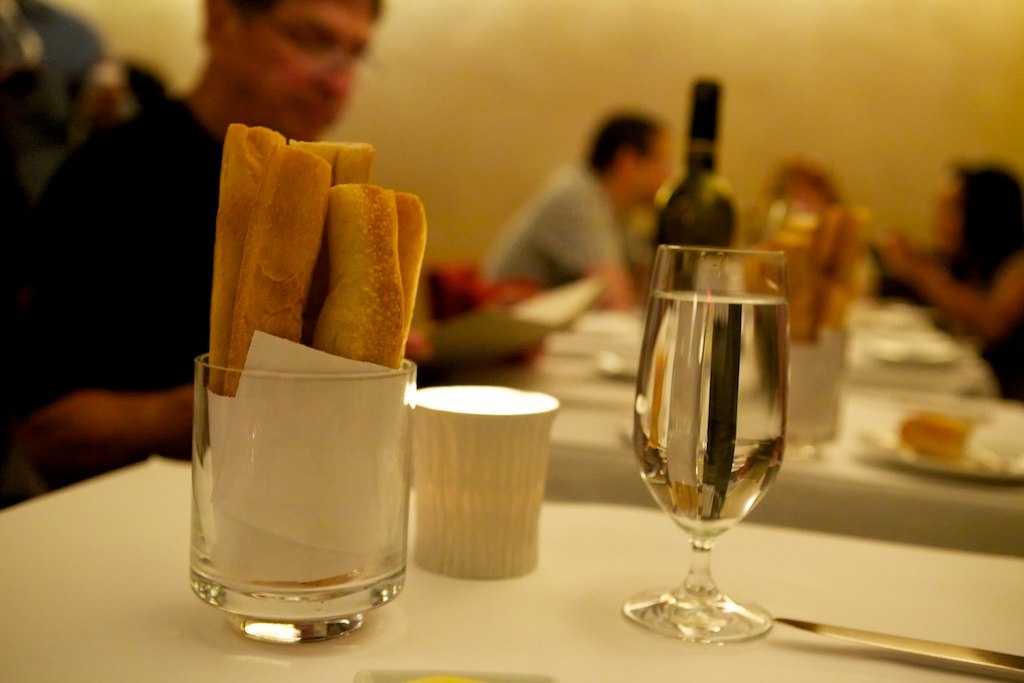
The next thing was our little complimentary amuse bouche — two teeny-tiny “burgers” made of snap peas on an almond bun. This was exceptional — easily the tastiest thing of the night. I could make a whole meal of just these, but sadly, you only got one-per-person, and they’re roughly an inch wide. Just delicious, though. And free!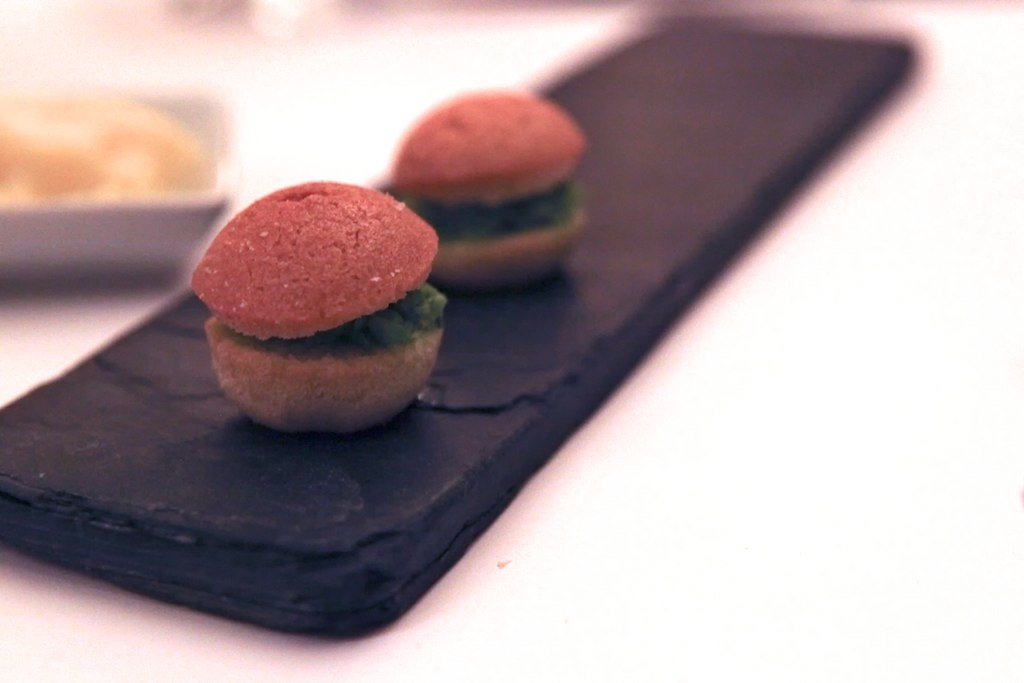
We each ordered salads, as it would be crazy to visit a farm-based restaurant and not order something consisting entirely of this fresh produce. Mine was the summer vegetable salad. It came with the greens in the middle (with the dressing underneath), and the other vegetables around the edge of the bowl.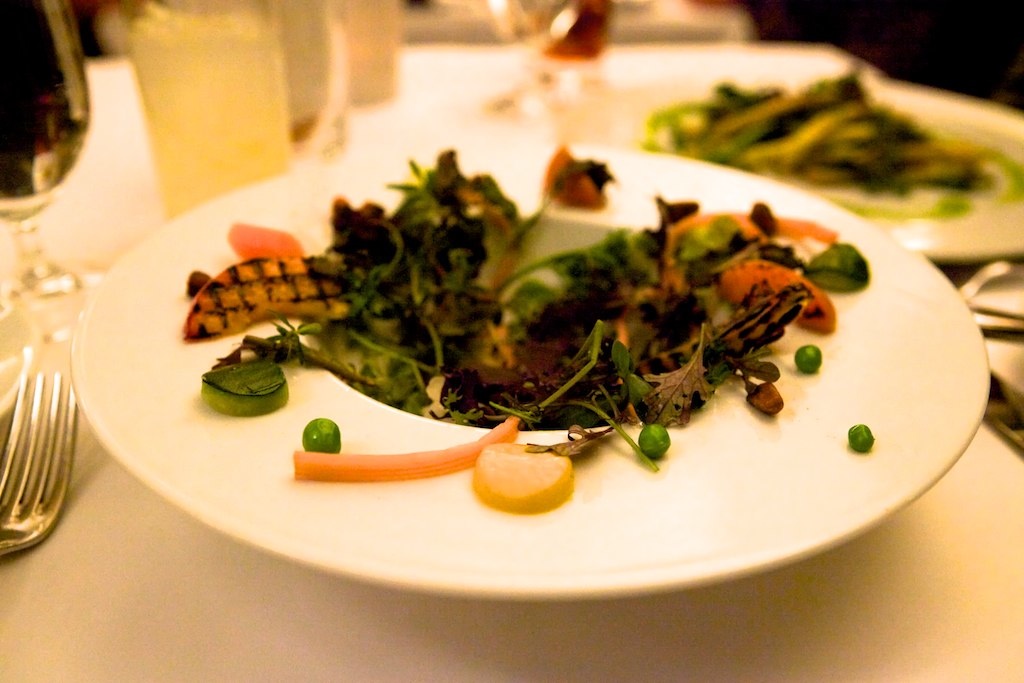
After mixing it all together, it looked like this. It was very, very tasty. Incredibly fresh, with a delicate dressing that in no way masked the vegetables. It tasted like lovely, lovely plants, and for a moment, I felt like a deer. There was a small part of me that thought it seemed a bit basic — and small — for $16.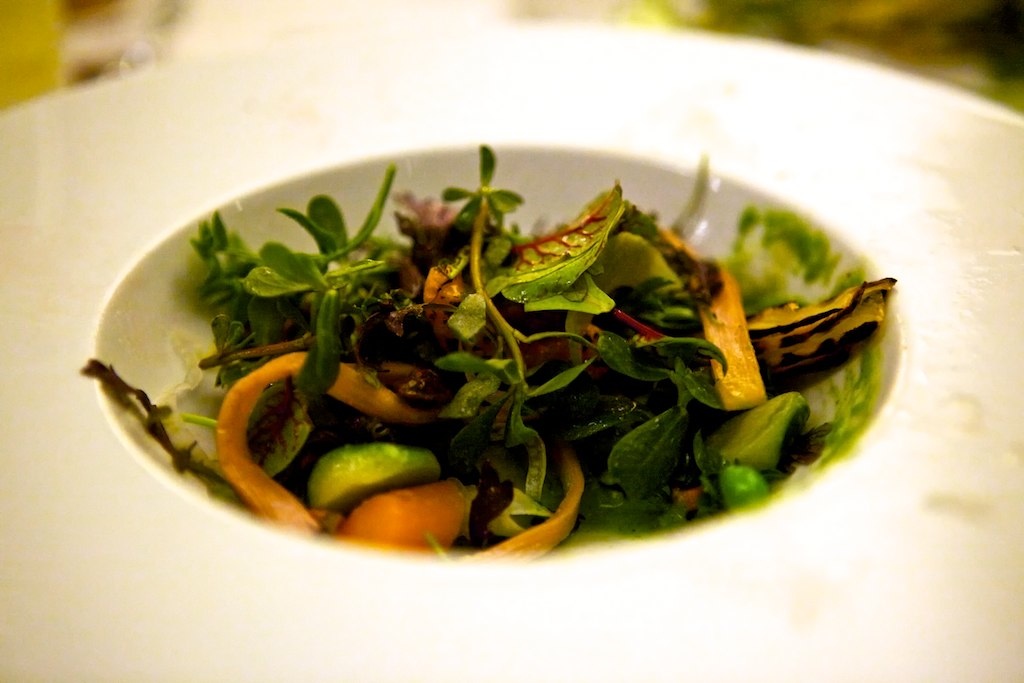
AEJ ordered the summer bean salad. If your idea of ass-kickin’ excitement is an absolutely perfect bean, then this salad would definitely knock you on your ass. These beans were, no exaggeration, perfect. But they were beans. And they took up less space in real life than you’re seeing on your monitor. $15.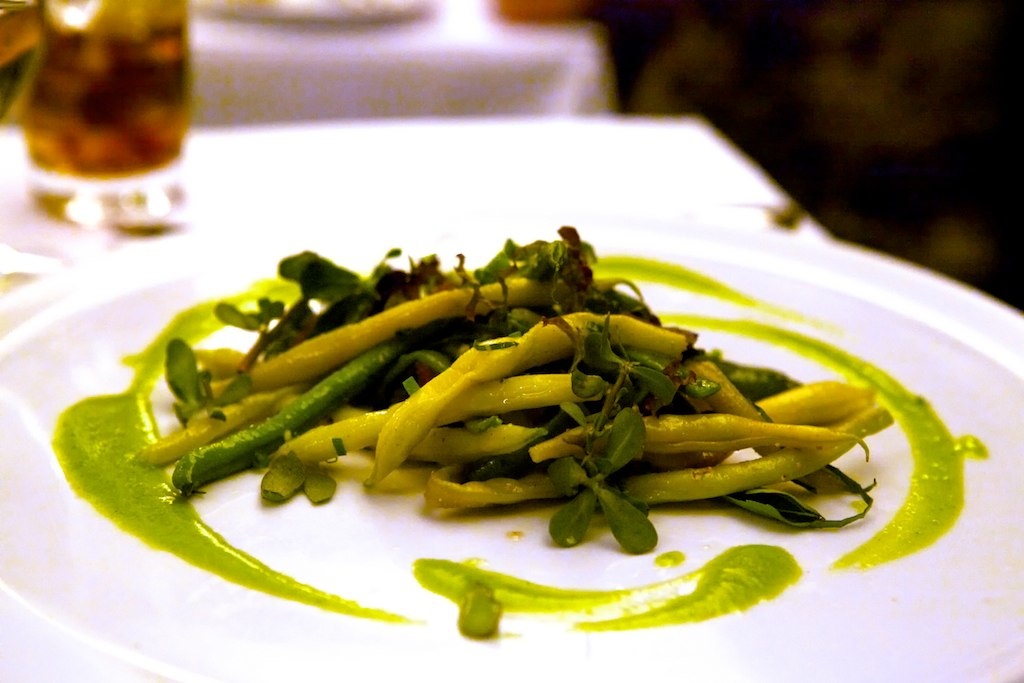
For her entree, AEJ opted for the vegetarian option, figuring this place would know how to prepare vegetables. Sometimes, AEJ orders the vegetarian tasting menu because it forces the chef to be more creative to make an entire dinner interesting without using any meat at all (not even bacon!), and there’s also the challenge for the chef to come up with something creative to justify the cost. When we ate at Hubert Keller’s restaurant — Fleur de Lys –in Las Vegas, AEJ’s vegetarian meal was much more interesting (and delicious) than my traditional meal. (If you haven’t seen Hubert Keller’s “lady bug of plum tomato,” you should check out my Vegas blog entry.)
This is Blue Hill’s “zucchini steak” — ricotta cheese, curried almonds, olives, and emmer wheat. To me, it was a little too vegetarian. It tasted like grains and vegetables. There was no pop of flavor, no real spice, just… zucchini and wheat. $28. Let me say that again. $28.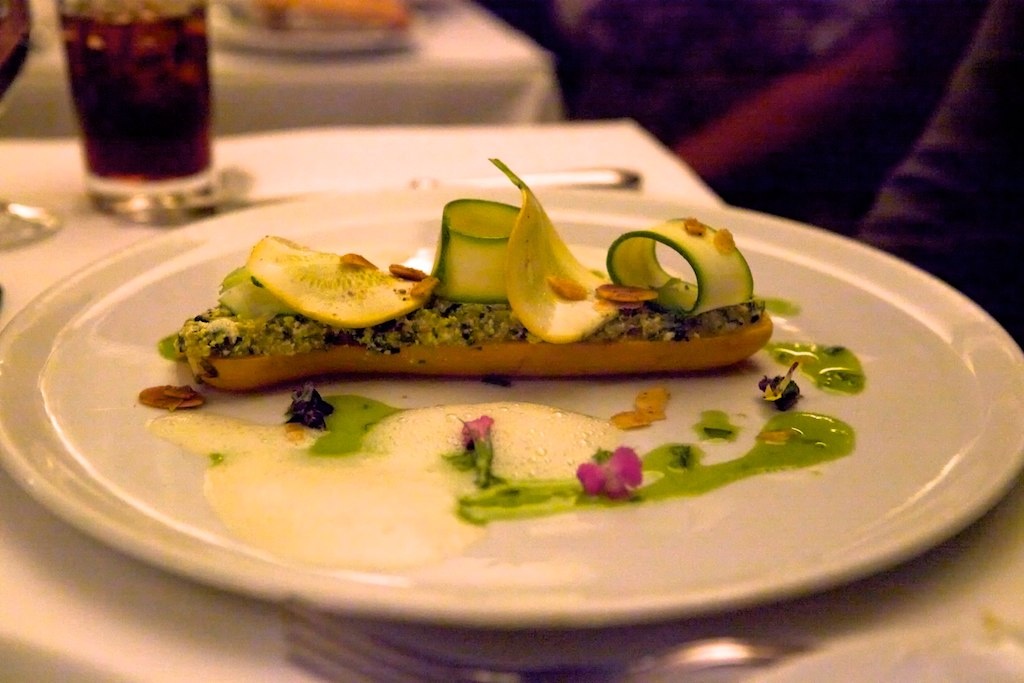
My entree was the ravioli with pork belly. This was delicious. The pork crisped up on the edges, the fat melted in your mouth. It was definitely good. There were, by my count, four bites of pork belly, and maybe a half-dozen nickle-sized ravioli. Price? Never mind. At this point, I just started chewing on my wallet.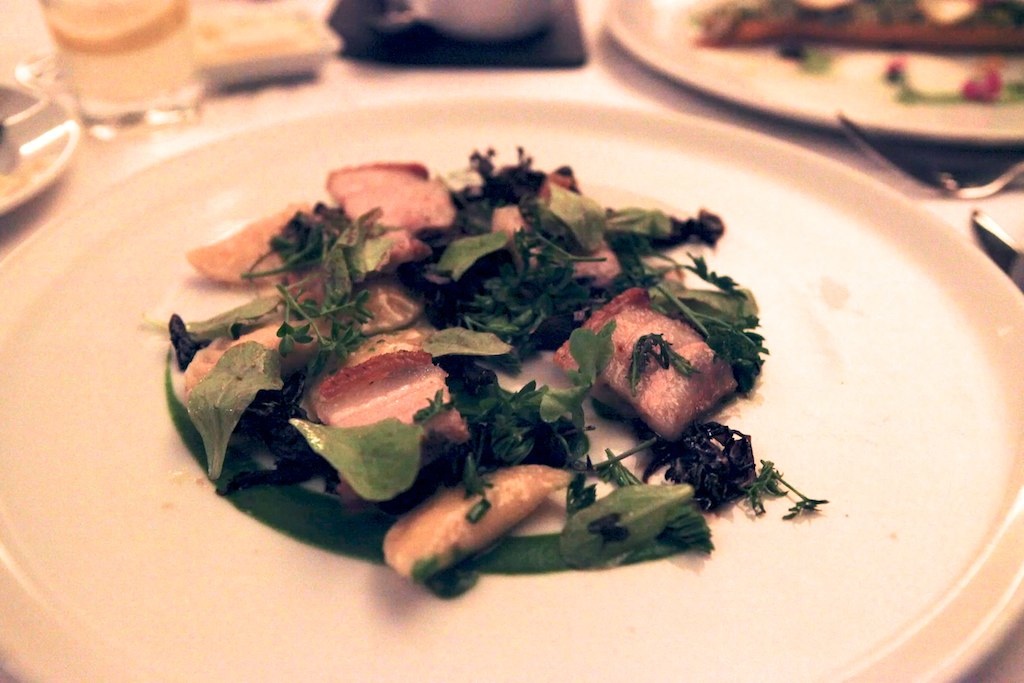
My dessert was the chocolate bread pudding — molten in the middle — with vanilla ice cream. Again, very tasty. Not exceptional — not massively chocolaty or rich — but good. Why they chose this course to not include any fruit is a little beyond me.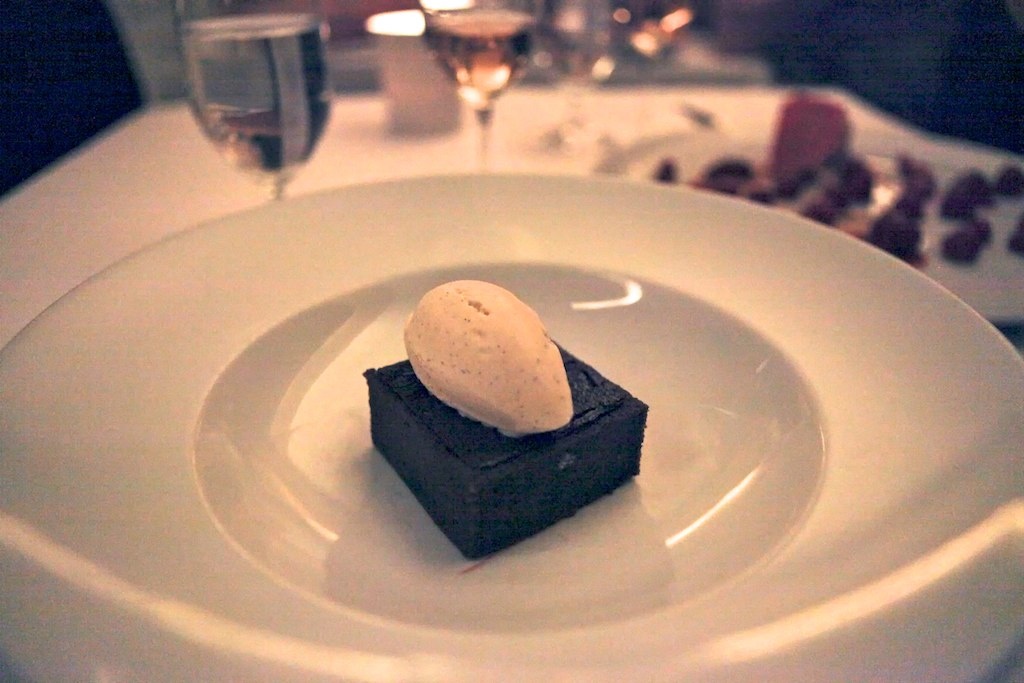
The lack of fruit in my course was remedied by AEJ’s dessert, strawberries with Blue Hill Farm jam, peanut butter ice cream, and some incredible peanut butter-type goo. As AEJ said, “these are the best strawberries I’ve ever tasted in my life.” I tasted one and agreed. And the peanut butter was really something special. The desserts were both quite good — AEJ’s won, though, by far — and were a relative bargain.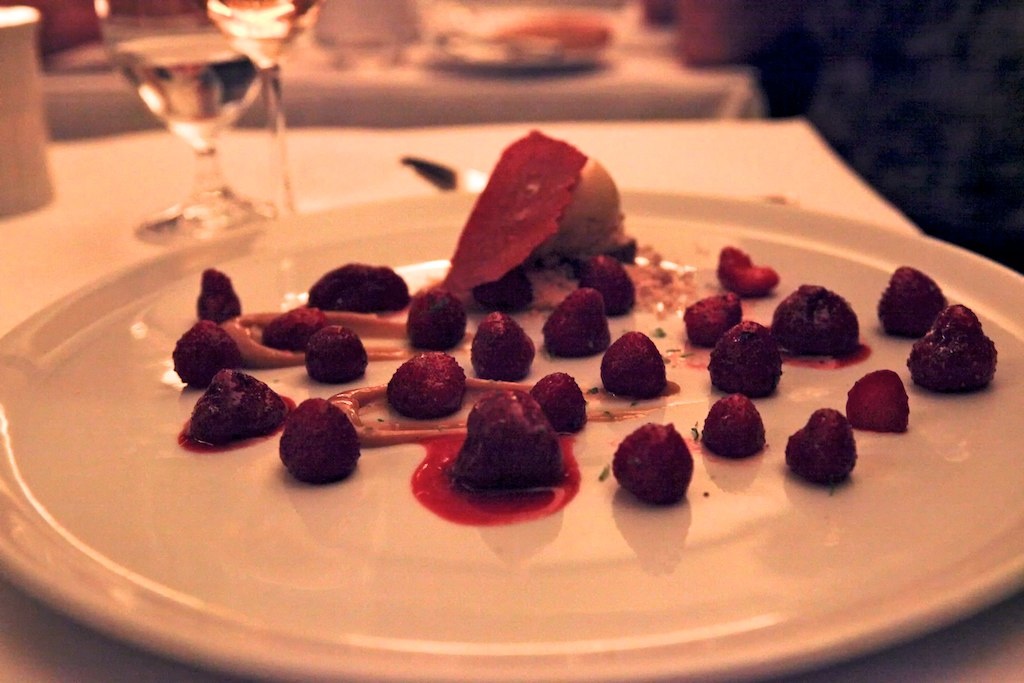
So that’s Blue Hill. To be clear, it’s very good. The ingredients are fresh — probably picked (or slaughtered) that day, all organic, just perfect. The presentation is minimal, a celebration of the ingredients, not of innovation. The portions are extremely small, as if each course were part of a 12-course tasting menu, when in fact, these were the full-size portions. I’m not a big eater — I love food, but I don’t need a huge portion of anything — so my complaint is not that there wasn’t enough food. My issue was that for the amount of food presented, the prices were astronomical — and, to state the obvious (if you’ve been reading the blog for the past five years), I’m not normally one for, um, pinching pennies at a nice dinner. That’s our big splurge. But that said, this felt awfully expensive for what it was. It was so minimal that one could go to Wheatsville CoOp in Austin, buy a bunch of local organic ingredients and a Niman Ranch pork belly and put something very similar together for a whole lot less money and feel just as good about not trucking your vegetables from 1000 miles away. As AEJ said, “I feel like at Blue Hill, all I’m paying for is not having to walk to the farmer’s market myself.”
I sort of think that if Blue Hill were anywhere besides NY or the Bay Area, people wouldn’t pay these prices for fresh vegetables. But if I apply that logic to any restaurant, nobody would pay NY prices for much of anything outside of NY. If you eat in NY, you have to pretend you’re at Disney World or the airport, and just accept that a soda is $4 and there are no free refills. (Does that sound like a depressing fortune cookie? “There are no free refills in life.” So true. So true.)
View Comments
Comments
Add comment
July 4, 2010
Eleven Madison Park
It’s been an amazing couple of weeks in NYC, thanks in no small part to the incredible restaurants. There was the good-if-slighly-overrated Morimoto, the fun and creative evening of molecular gastronomy at WD-50, a downright perfect Italian meal at Scarpetta, and several other good (but not photographed) meals. Last night, though, was the epic meal of the summer: The 12-course “gourmand” dinner tasting at chef Daniel Humm’s restaurant, Eleven Madison Park.
The first thing you notice is the staff: all young, and genuinely friendly. A lot of restaurants at this level can be overly-serious, bordering on snooty. My preference is for the food to be taken seriously and treated respectfully, but there’s no reason to be uptight about it. I don’t want to feel like I can’t have fun and wear my clown shoes to dinner. The extremes, at least in tone, have been Jean-Georges — where a jacket is required and the majority of the clientele is so elderly that you’d swear some have been embalmed — and at the other extreme, WD-50 — where almost everybody is under 45, and there’s no dress code at all. Both places have brilliant food (Wylie Dufresne, the chef at WD-50, used to work at Jean-Georges, and in fact, Jean-Georges is an investor in WD-50), but the tone (and, well, the food) is completely different. Eleven Madison Park is closer to Jean-Georges than WD-50, both in mood and food, but it manages to remain just-shy of any hint of stuffiness. It’s a room full of smiles.
When you sit down, you’re presented with a little bowl of warm Gougeres to nibble on while you look over the wine list. Er, wine book. The thing was just huge — probably 150 pages. It was like the “Mission Earth” of wine lists. (Did you know that L. Ron Hubbard’s book, “Mission Earth,” is the longest novel in the English language, with over 1.2 million words? And what a page-turner it is!)
Here’s our next plate of hors d’oeuvres (two of each) — from right-to-left, a sweetbread pocket (we skipped this; sweetbreads give us the fear), a mushroom tart, foie gras and jelly (not sure what kind — currant?) with black pepper on a cracker, big-eye tuna, and a carrot marshmallow. The carrot marshmallow was the best part — sweet, bouncy like a good marshmallow should be, and… carroty. You probably think I’m kidding, but it was magically delicious. (Where have I heard that before?)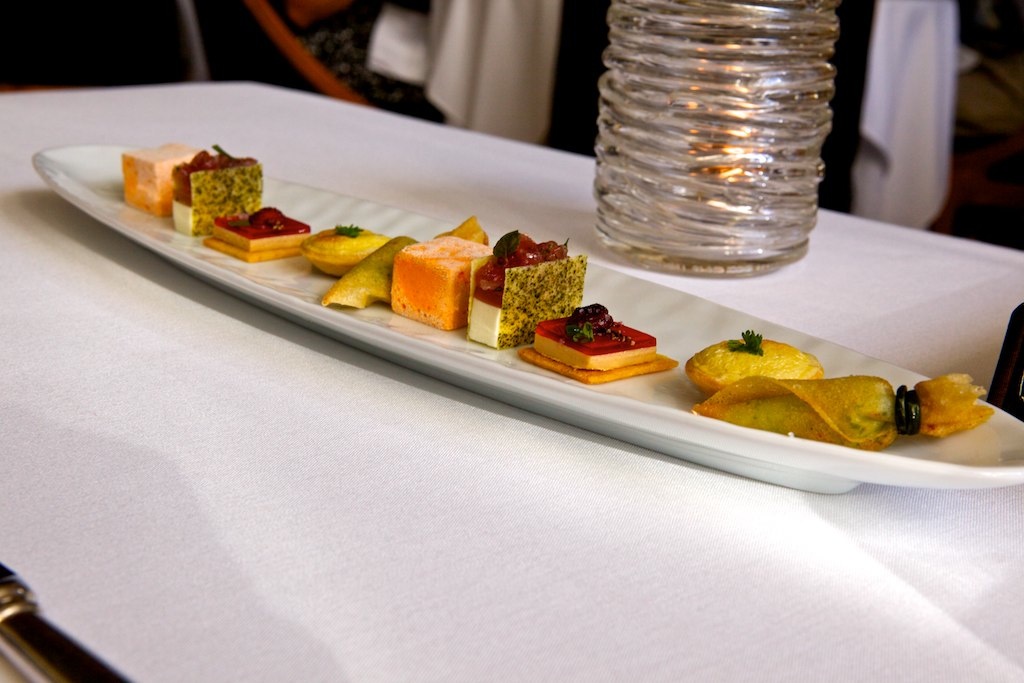
Cocktails! AEJ ordered the Velvet Cobbler: Amontillado sherry, Mosel riesling, and lemon verbena. It tasted (and looked) like the kind of drink that only men would drink, in, say, 1945. Well, except for the strawberry garnish.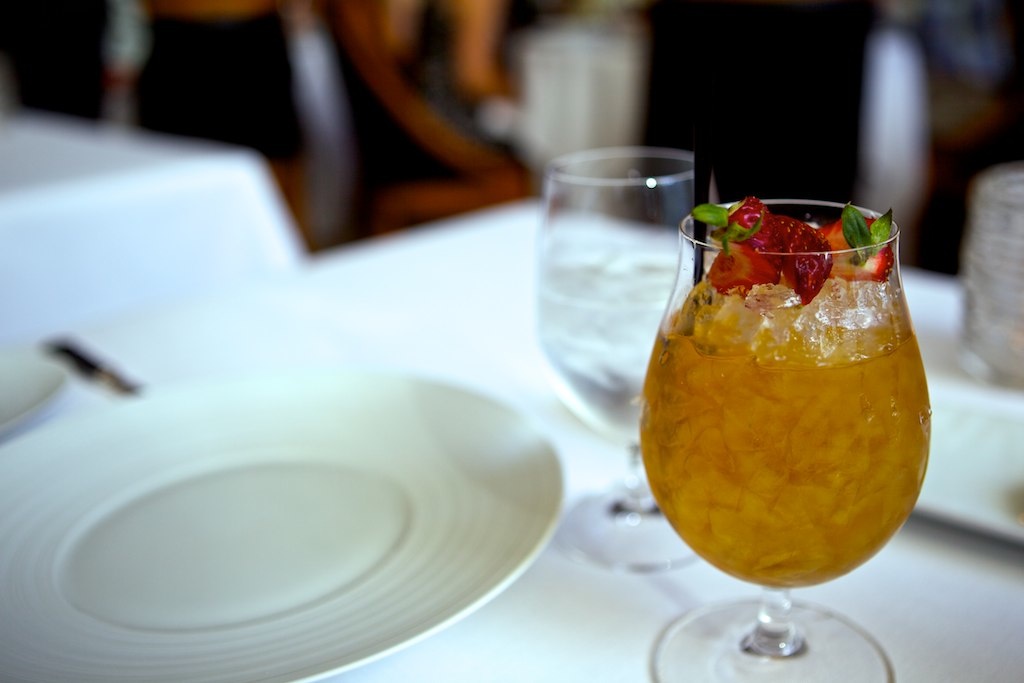
Turns out mine looked awfully girly by comparison. This is the Devil’s Buck (a decidedly not-girly name) : Lowland blanco tequila, Creme de Cassis, ginger, and lime. (That lime on top is turned inside-out to hold the shot of creme de cassis.)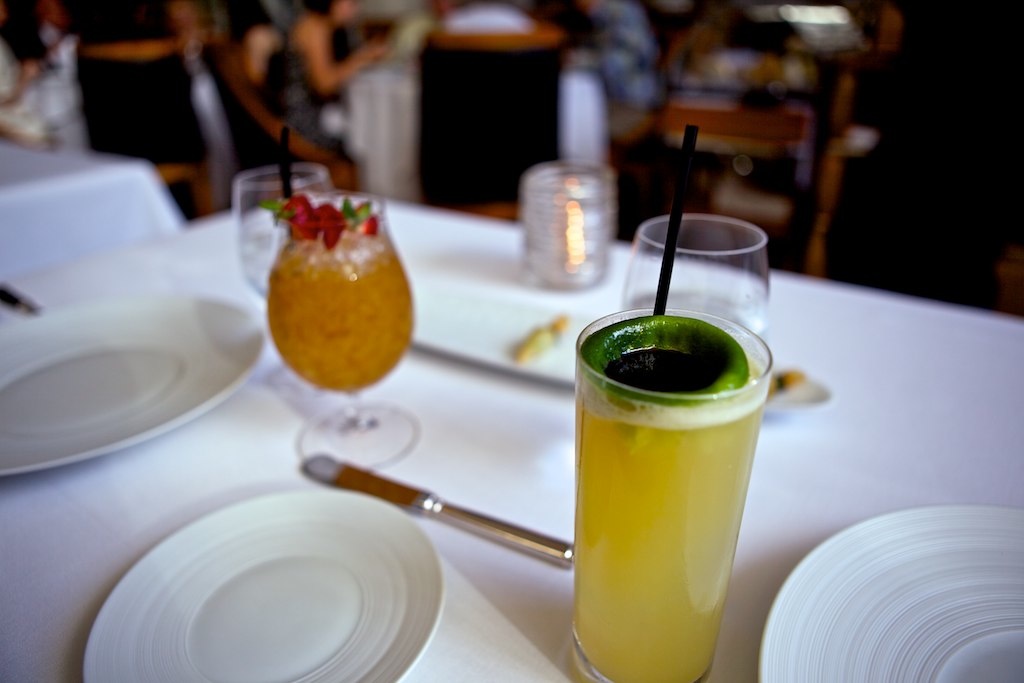
Bread and butter! Two butters, actually — cow milk butter on the left, and goat milk butter on the right, with a little bowl of fleur de sel (ie, course salt).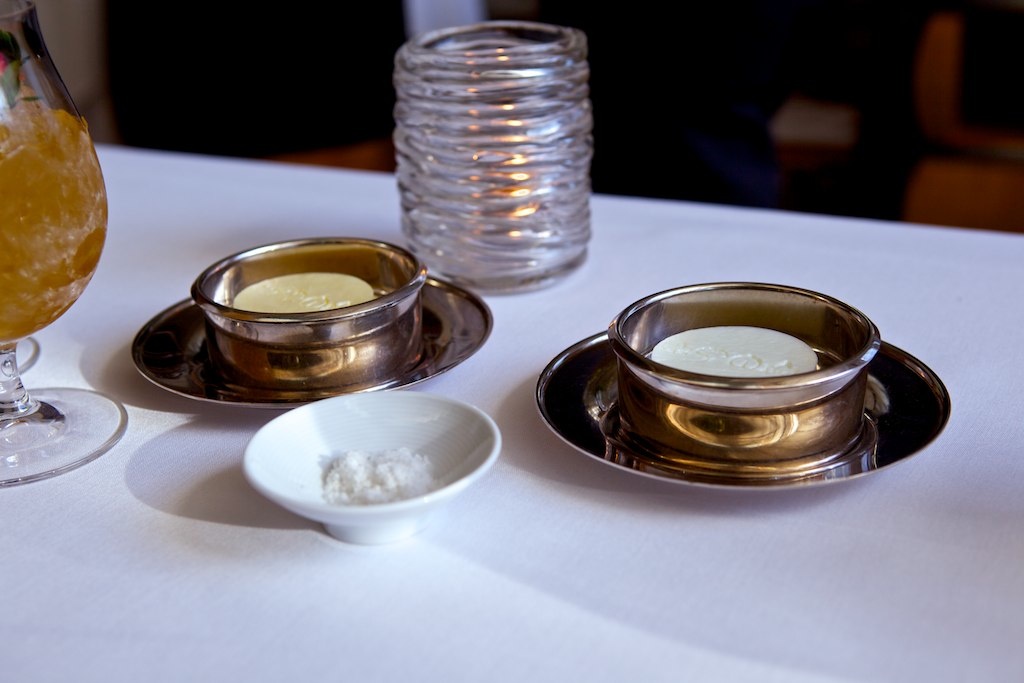
Things started light and fun. This is the Tomato Lollipop (presented in a basket of cherry tomatoes) : tomato, Taggiasca olive, and basil. The tomato, as far as we could tell, was tomato ice cream. This was sensational.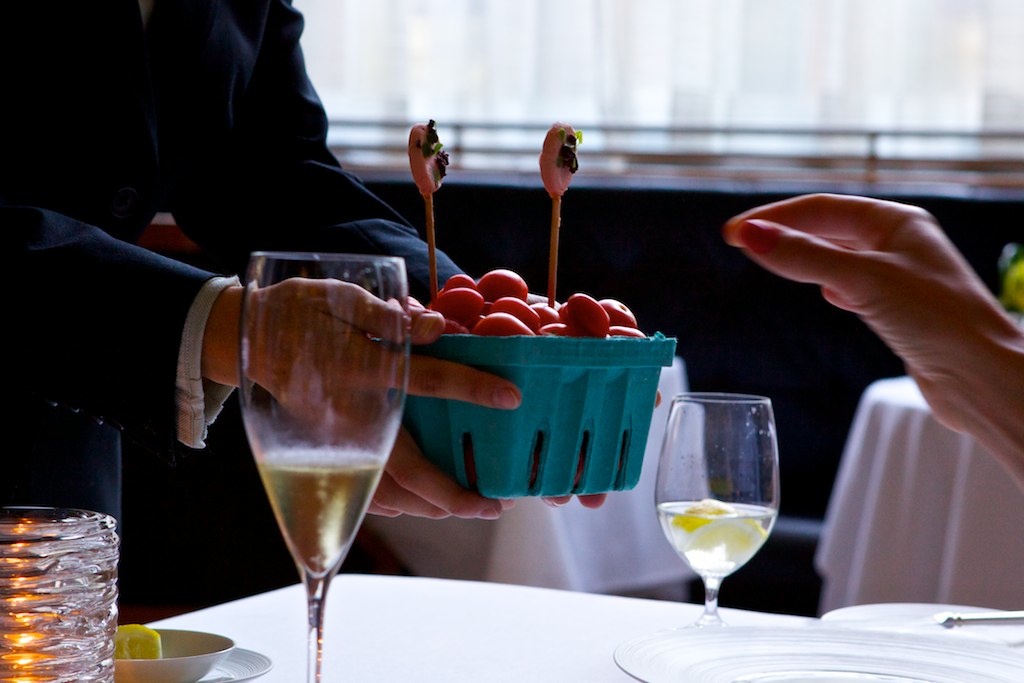
I love corn soup. This is chilled sweet corn soup with summer truffle, radish, and purslane (an eatable flower). The corn, like everything else, was ridiculously fresh — almost as fresh as I was feelin’ after a few courses of wine. ZING!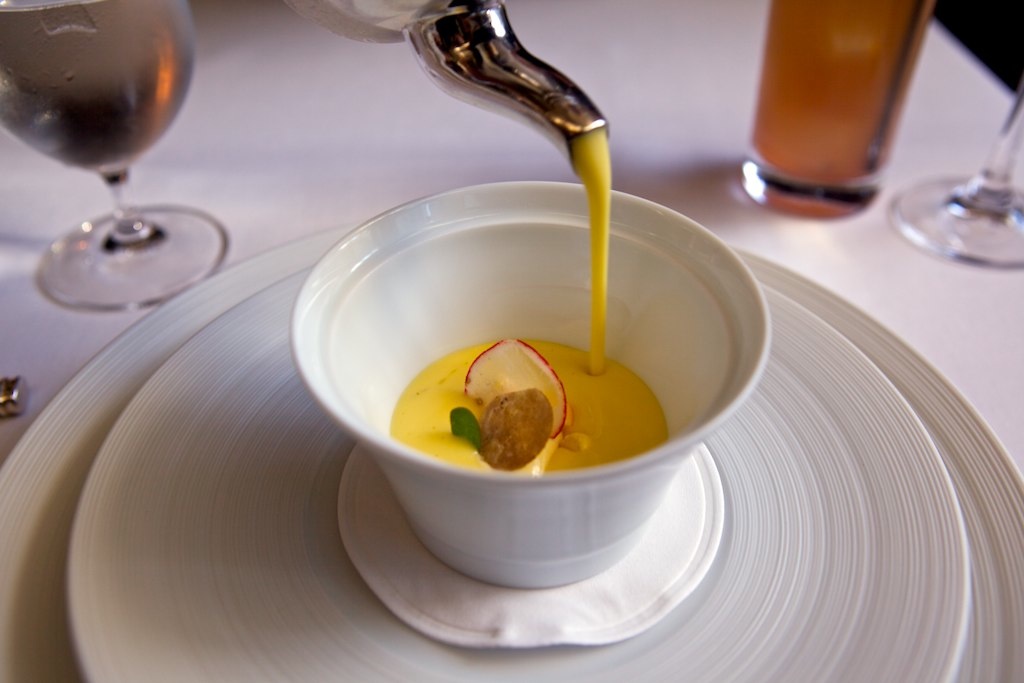
Speaking of the wine, we ordered the wine pairing, specifically requesting that the wines be kept kind of on the light side. (We aren’t big fans of a chewy red wine.) In all, there were 10 wines, ranging from white to rose…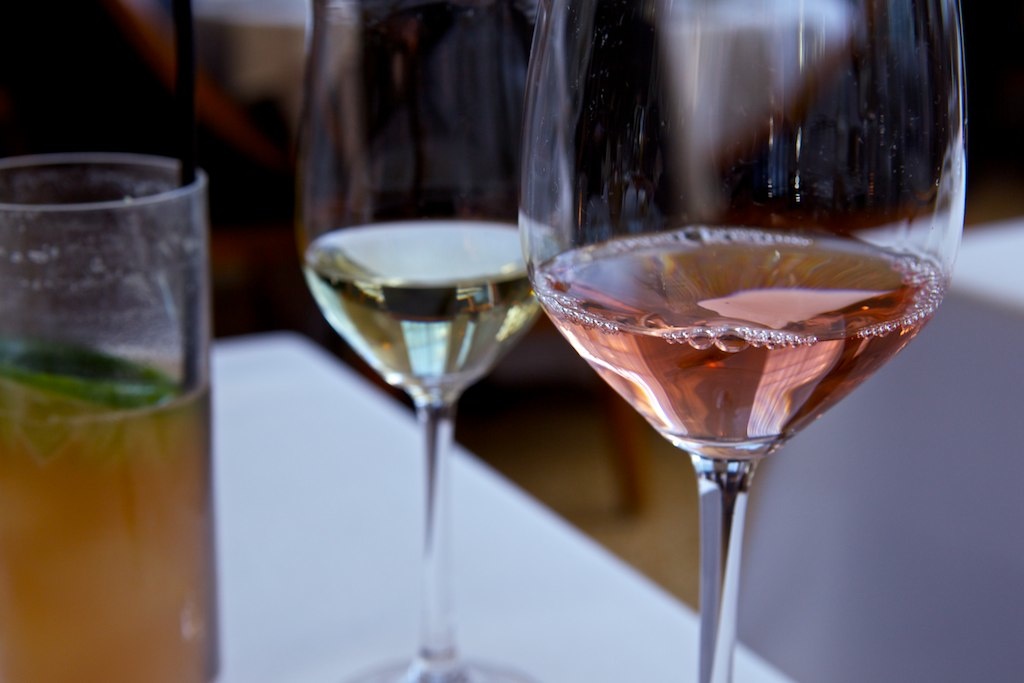
… to this Burgundy (according to our steward, it was “Domaine Jean-Marc Bouley, Clos des Chenes, Premier Cru, Volnay, Burgundy, France 2005” — but all I know is it tasted awfully light for such a dark wine), served in the biggest wine glass I’ve ever seen. (We were told that the glass could hold an entire bottle of wine. Now it’s a party!)
This is the Taboule salad with summer crudites (melon, etc.) and wild herbs. (I gave AEJ the cucumber. I hate cucumber.)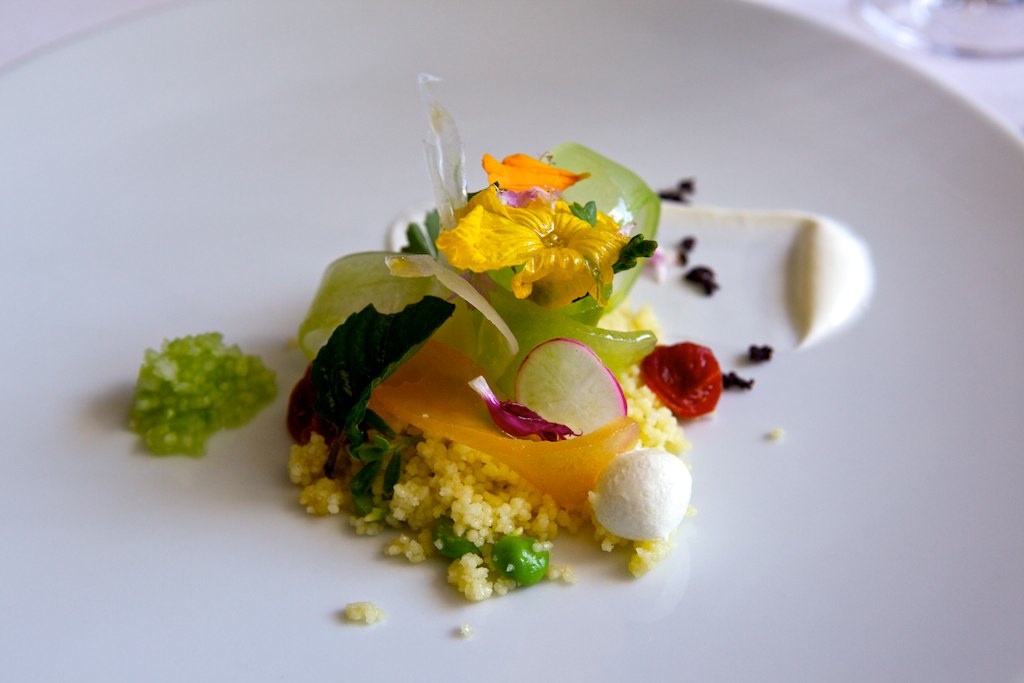
The next course in the tasting would have been rabbit, but we asked for a substitution, because I didn’t want AEJ to start crying thinking of a tiny bunny. The substitution was amazing: Goat’s Milk Ricotta Gnocchi with violet artichokes and bacon. This was good with its paired wine, but even better with my cassis cocktail. It was rich and gooey, and each bite tasted different, depending on whether you made a bite with gnocchi and artichoke, or olive, or that amazing sliver of cheese that you see on top.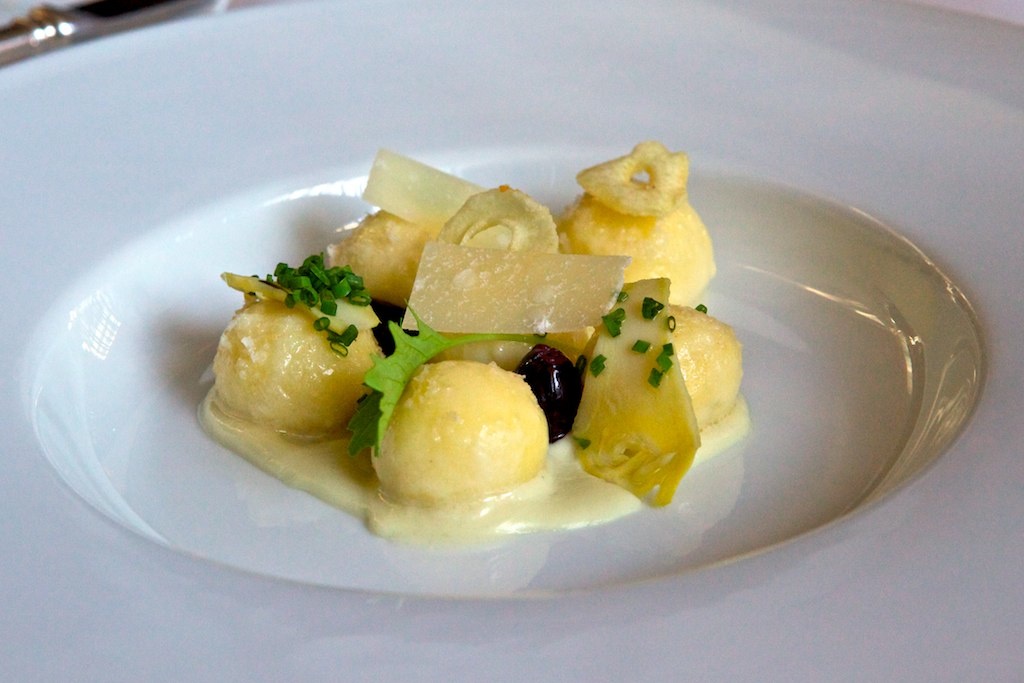
This is the Atlantic Cod Cheeks, poached in olive oil with sweet peppers and “piment d’Espelette.” The sauce was wonderful, as was the fish, but the sauce wouldn’t really stick to the fish for whatever reason. (The fish seemed a little wet.)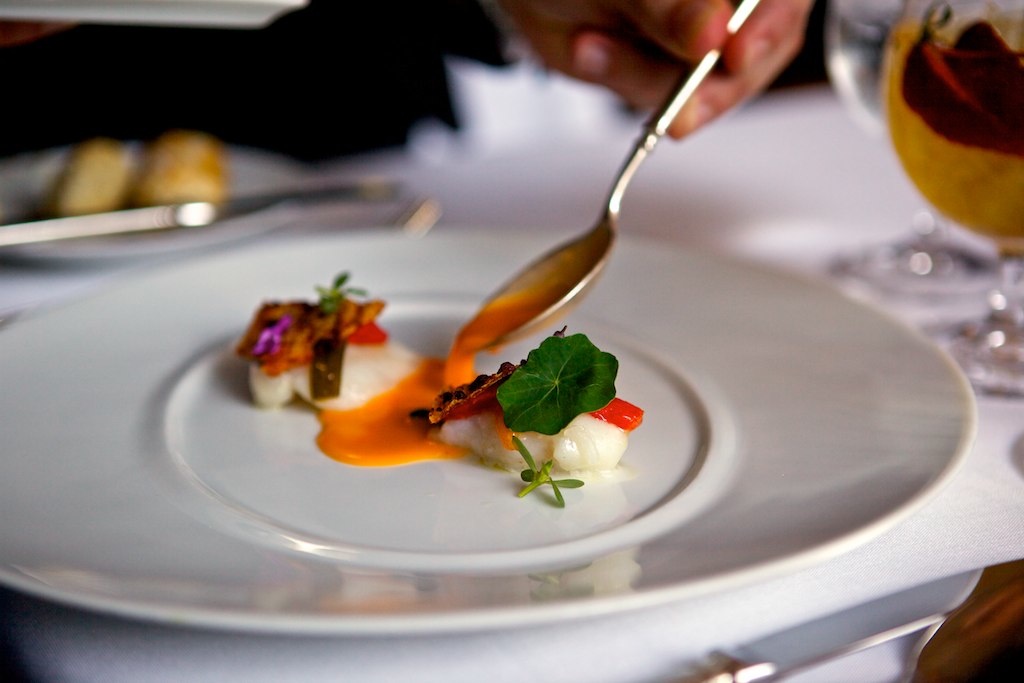
It looked very pretty, though. (I think every restaurant should use eatable flowers as a garnish, just because it makes a nice picture.)
For my next course, I had the Nova Scotia Lobster Lasagna with lemon verbena and heirloom squash. This — the broth in particular — was a highlight of the dinner. I also loved that it was called “lasagna,” but it obviously wasn’t a traditional lasagna. Even the lasagna noodles weren’t standard, but had been rolled in paper-thin flowers. (You can see a hint of a flower near the center of the frame.)
While I had the lobster, AEJ — who is allergic to shellfish — had the “Loup de Mer,” slow-cooked with cannellini beans and chorizo.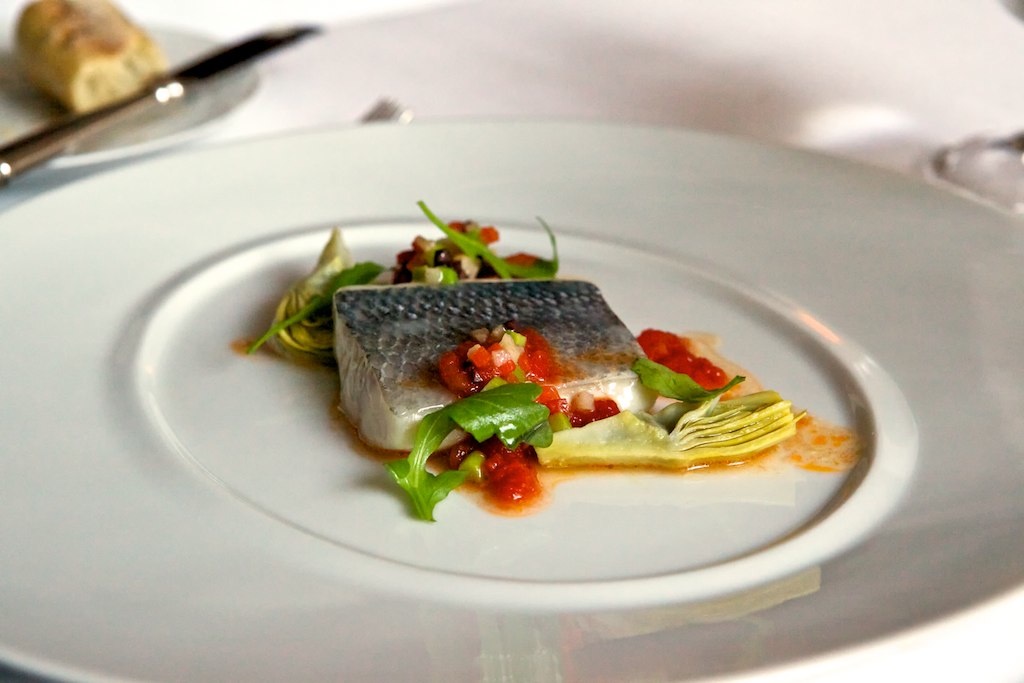
It wasn’t included in our tasting menu, but the table next to us had the duck course (stuffed with lavender — I believe AEJ referred to the duck as “lavender butt!”), carved table-side. (Those are some perfectly-polished copper pans.)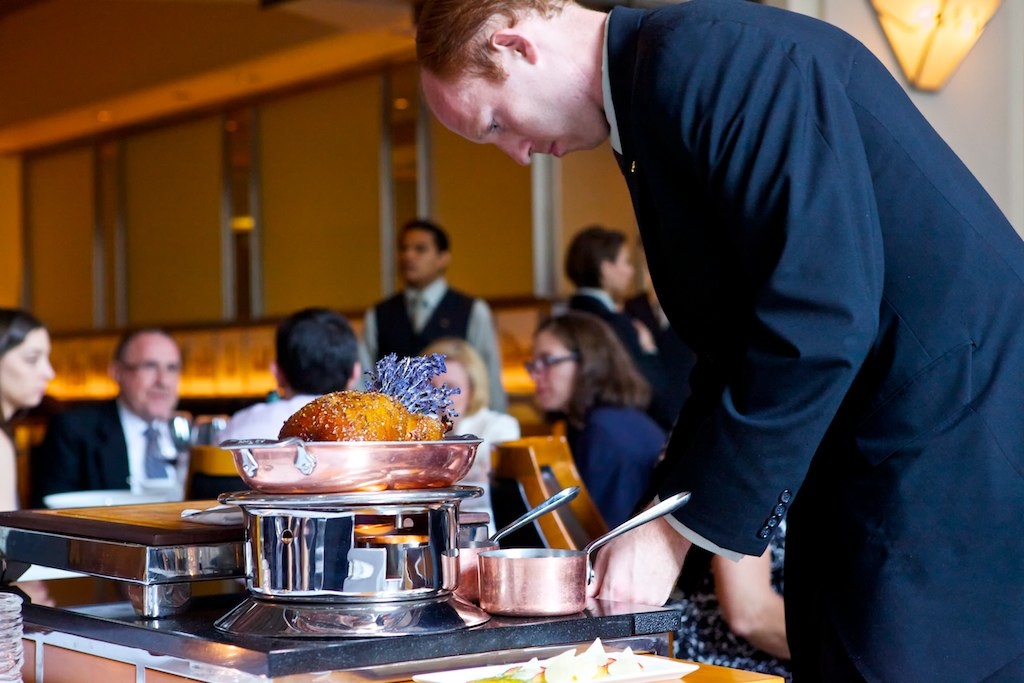
Here is the chicken, roasted with sweet corn, chanterelles, and farro. I know it’s silly, but I think it’s fun when the sauce is added at the table.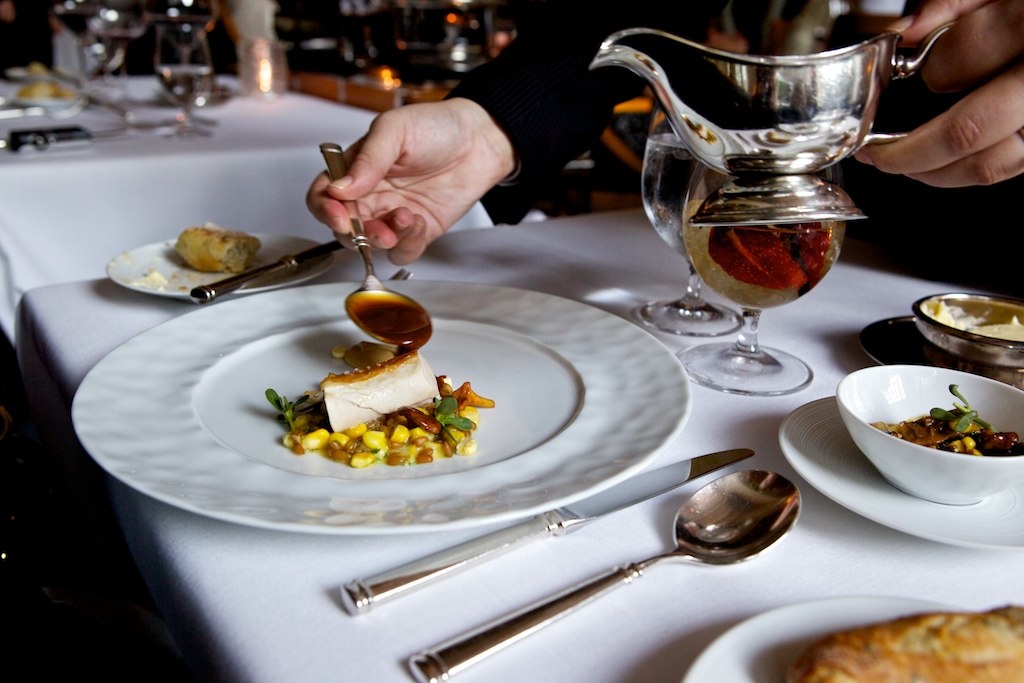
It also means you get two photos of the same course. (This broth, like the others, was intense and delicious.)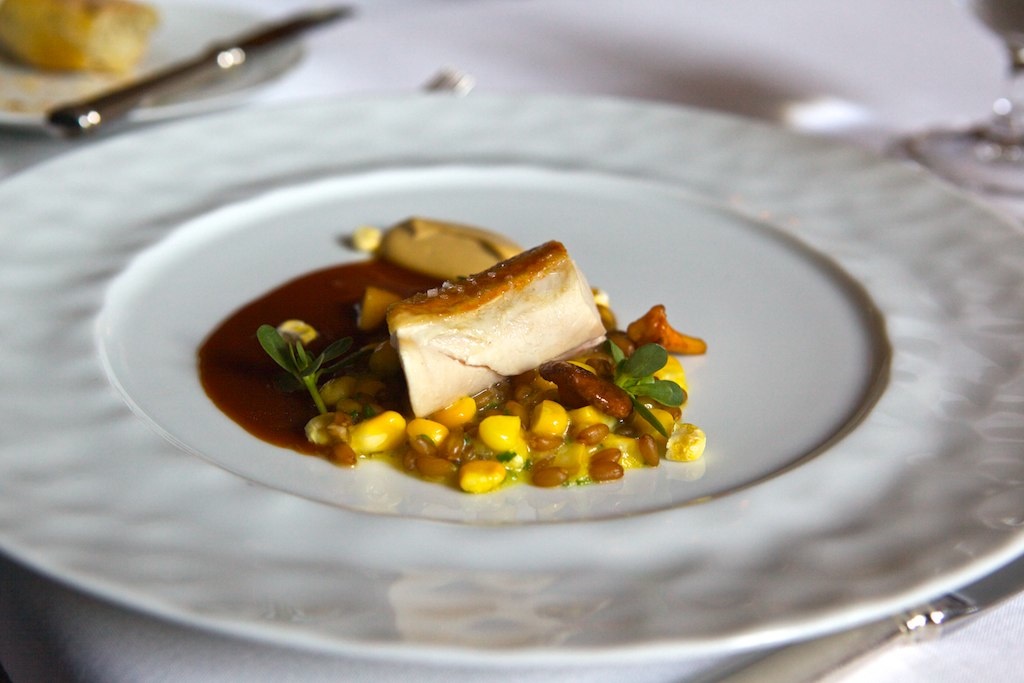
Next up: Colorado Lamb, herb roasted with eggplant, cumin, and yogurt. We think the lamb was cooked sous vide, as the lamb had been cooked at WD-50, and like WD-50’s lamb, the texture was rubbery. Maybe there’s a way to cook something sous vide and get a good result, but I haven’t had it (or maybe I have, but didn’t realize sous vide was involved). I’m all for tender, but meat this tender just resembles an eraser. A lovely, delicious eraser — like the kind you’d get at an art store — but an eraser.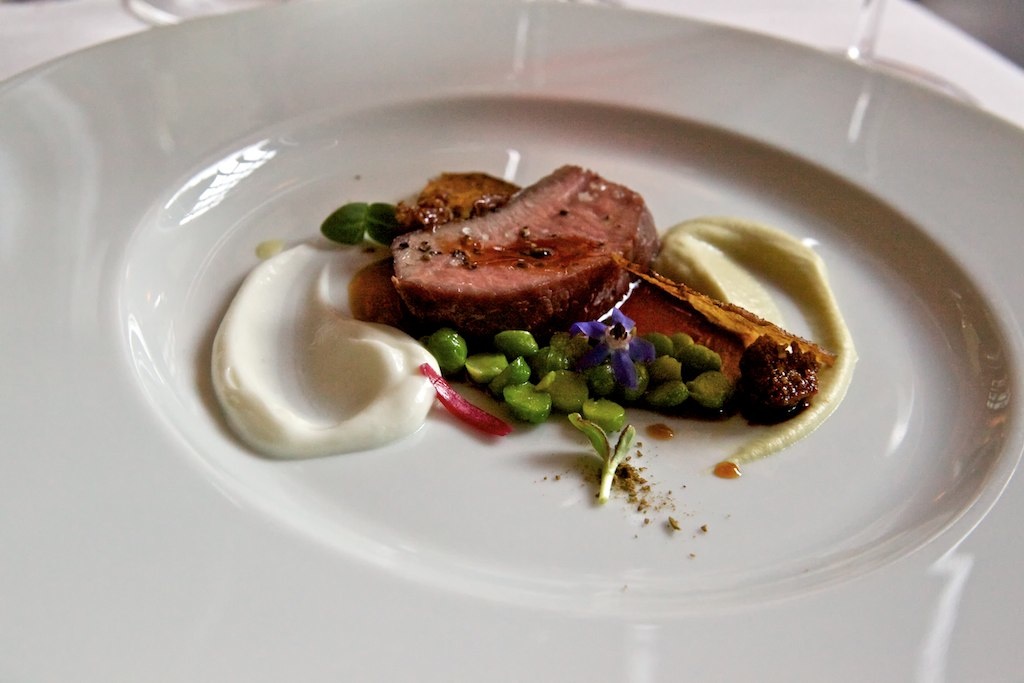
Look what’s at the next table! It’s the CHEESE CART!
The cheese cart is a fun course. We don’t know a great deal about cheeses. (I, in particular, am clueless, but I do know that I prefer Mexican Velveeta to regular Velveeta.) We don’t like cheese on the stinky side (Mexican Velveeta being the exception), so we asked our waiter for a mild selection. “A slice of your finest American cheese food, please!”
Our (exceptional) waiter, preparing the cheeses.
CHEESE! (and nuts.)
There’s something awfully cheery about the Champagne and cognac cart. (And again with the smiles!)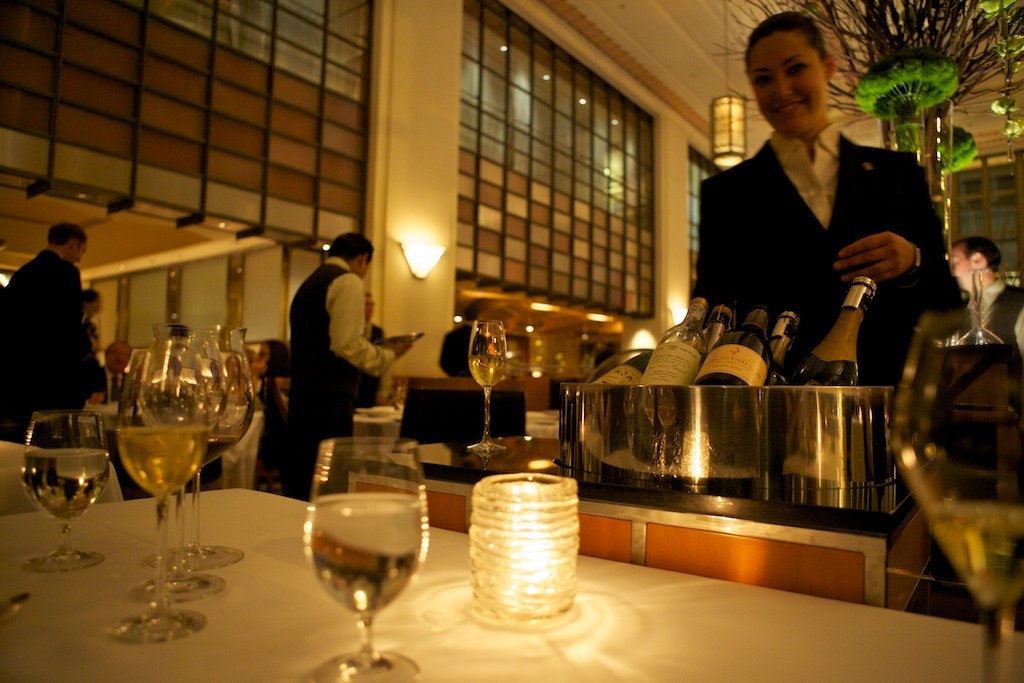
After the cheese course… desserts! This dessert doesn’t look like much, but I can still — even the next day, after 10 glasses of wine last night — remember how amazing this was, and what the texture felt like. It’s called “Milk and Honey” — a mountain of dehydrated milk (I suspect that liquid nitrogen was involved) that you crack open to release a river of lavender-infused honey.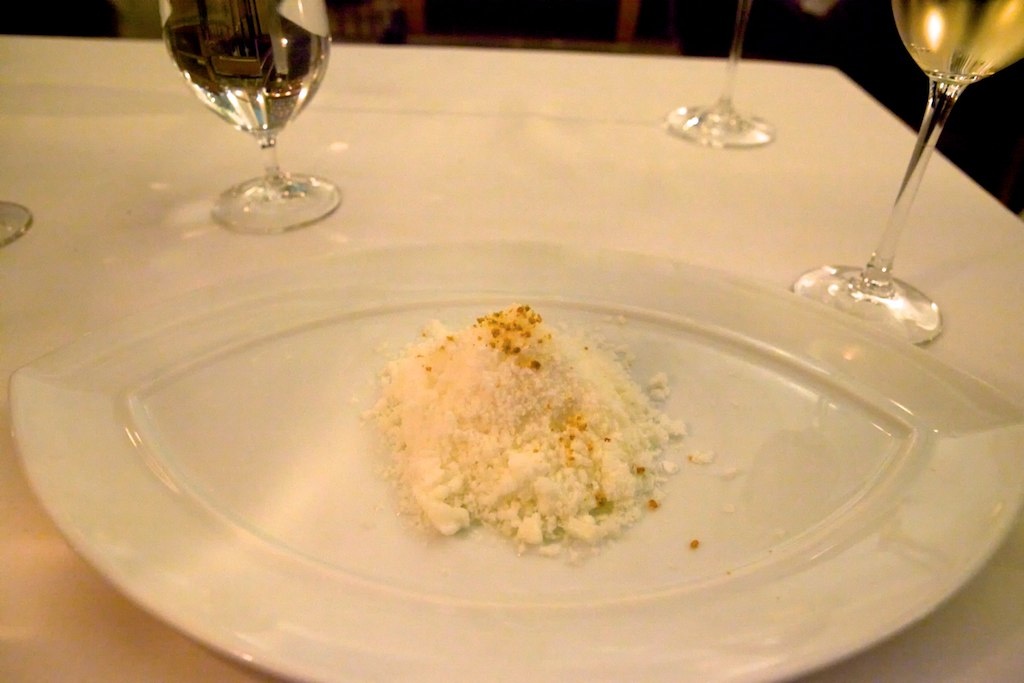
The next dessert was “bittersweet chocolate” –Cremeux with black sesame, caramelized banana, and yuzu. (More yuzu! It’s everywhere now — Morimoto, WD-50 — and I love it.)
And now — “mignardises” — in this case, macaroons. Which one should we have?
All of them, of course. (At this point, what’s another 400 calories?!) Each one was different. Peanut butter & jelly was our favorite.
We also had a pot of their in-house tea called “White Sunrise in Tibet.” We loved the tea and asked for more information about it. Minutes later, our waiter brought us a card with details about the tea — and the address of a store that carries it — all on a printed card. He also brought us copies of our menus (a slightly different one for each of us, since one course was different between them), including our personalized wine pairings for each course.
After tea: a glass of cognac. I don’t think I’ve ever tasted cognac before. We have a bottle in the house, but we only use it for cooking. (Some recipes of Ina Garten’s have you add cognac and then set fire to it. Very dramatic.)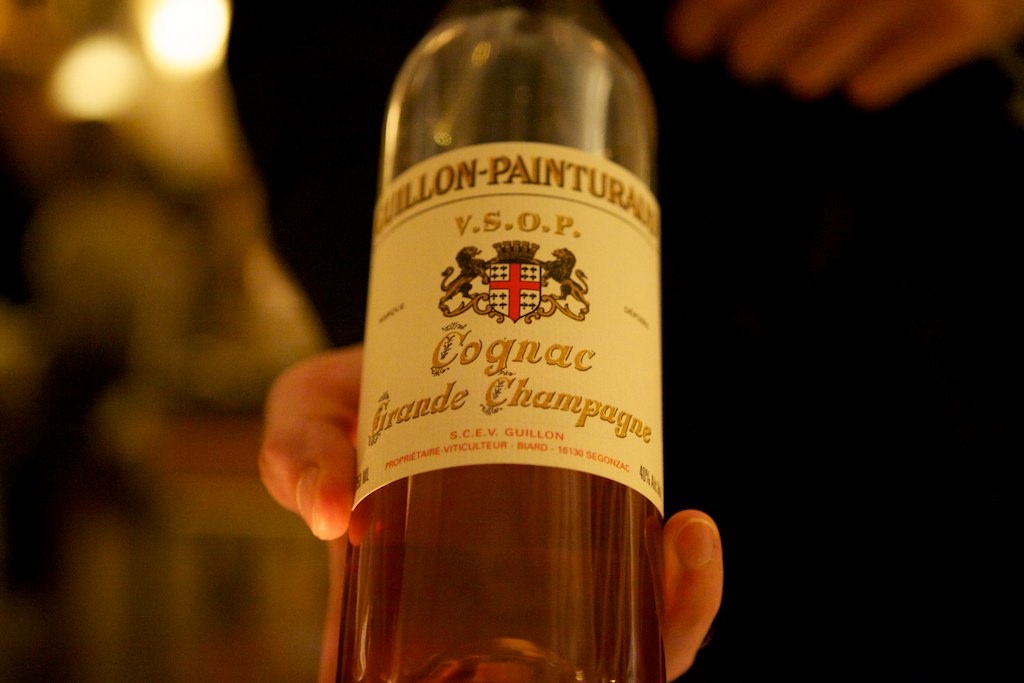
Finally, they brought us little boxes of jellies (“fancy Cluckles!,” as AEJ called them) to take home.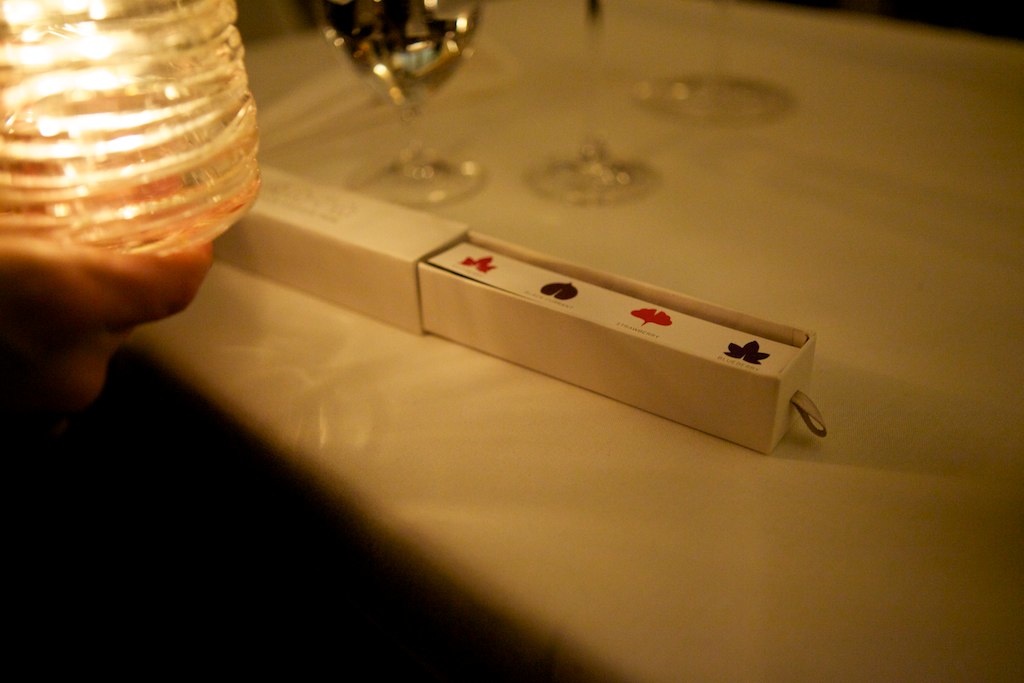
We also got a private tour of the kitchen (which is huge, bustling — and spotless). They don’t encourage photography in there, though — which was fine with me. I don’t want people taking my picture when I’m working, either.
We also met the chef, Daniel Humm, who is even younger than I am, and I hate him for that. Very nice guy, too. (If I were as talented as he is, I’d be an ass. Er, more of an ass.)
We had an amazing night — and it was a full night. We got there at 6pm and left around 11pm. (You can tell from the pictures that it got darker… and darker…) I’d rank it up there with Alinea (still my favorite restaurant), but maybe just a little lower in overall creativity. (It’s going to be tough for any restaurant to ever beat the wintertime campfire dish at Alinea.)
My sampling of restaurants is small, but Eleven Madison Park is definitely the best meal I’ve ever had in New York. I loved it.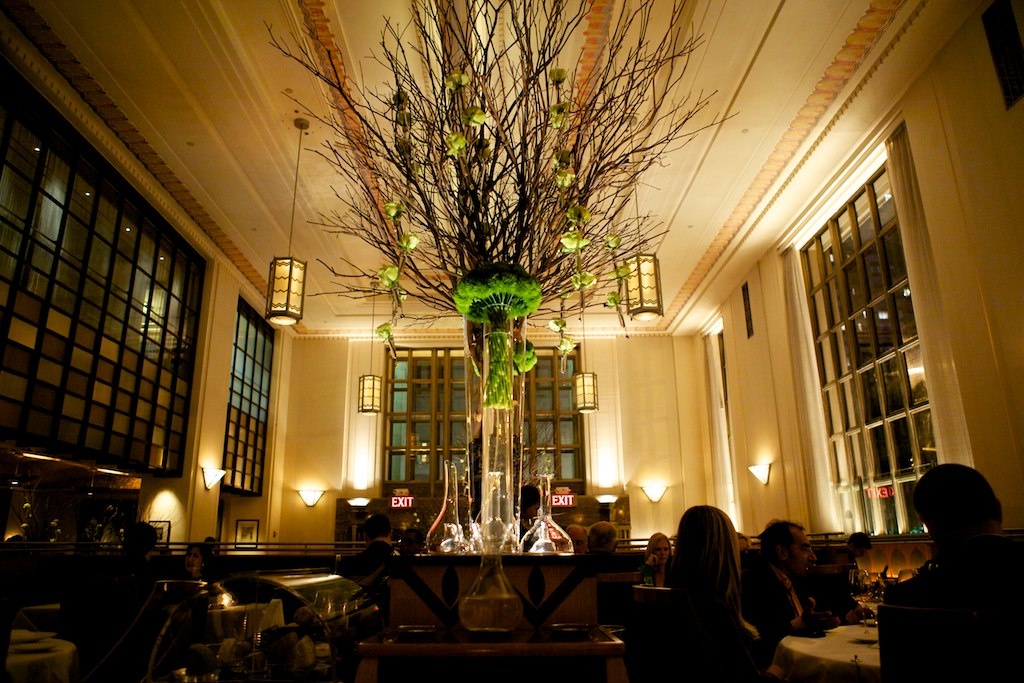
Up next, Blue Hill on Monday night…
View Comments
Comments
I love that you use pictures to document your blogs :)
I'm currently listening to the MP3 of 'Aurora Awakes' by UA, and it makes me smile. I live in Alabama and had plans of going into the school of music at the University, but money really got in the way. Anyway, I saw the University of Alabama Wind Ensemble perform it there for...I think the first time, and it was truly amazing. It's still one of my favorite pieces. I hope you had a happy 4th!
"Magically delicious?" That's the slogan for Lucky Charms. Fitting, actually, since you were talking about a carrot marshmallow. :)
I absolutely love your sense of humor. The light-hearted tone and overall sarcasm seems so different from the profoundness and overt resounding superiority of your music one would think they (the author of the blog and the composer) were two completely different people. A compliment, though...
View Comments
Comments
Chris Lexow says
John, Looks like a great piece! Can't wait to hear the midi for it! Congrats on a i'm sure to be successful slow piece!
Shawn Smith says
Looking forward to this John!
Andrew Hackard says
I need a bigger monitor if I'm going to try to read scores.
One question: in measure 11, the second bassoon is playing a C-flat. Why'd you note it that way, rather than just B?
RMC says
Okay John, I'll give you less shit now and try to be for fun . . . at least for a while! Glad you enjoyed writing the piece and I can't wait to study and program it with the UT Wind Symphony.
Matthew Saunders says
Looks like a fun piece, John. I think the best composers are always learning and pushing themselves in directions they haven't considered before, or which they have considered but haven't been satisfied with the results. There's nothing more boring than being stuck in a rut, even if it's a loud, fast rut. Best wishes for the premiere!
rerodriguez says
I kinda flipped out over this.
Blue Hour is my favorite time of day
Well... my favorite part of the day WAS twilight in general, before the name got sullied.
Thanks a lot Stephanie Meyer.
Can't wait for the MIDI.
Robert Benton says
John,
I think at least part of the reason a lot of band music these days is fast and loud is because of an inferiority complex. Bands are starting to get so good that they can often compete directly with the orchestral world, and they want to prove themselves as a valid medium. In all fairness, they've been wanting to do this for a while, but it's only been recently that bands have developed the ability and had enough quality music written for them to stand a chance.
I'm a euphonium player, and we have the same problem ("our instrument is just as valid as any other!" *sniff*), but it's manifested in a different way: In every euphonium solo or concerto, there is an impossible lick (I call it the "euphonium lick") that seems designed to drop the jaws of the musicians in the audience. Kind of a "See?-We-really-CAN-do anything! (please, please write more for us...)" moment.
Robert Benton
PS: I'm looking forward to playing--well not playing, but rather sitting aside (as there is no euphonium part) and watching David Jackson play--Harvest this fall at UM.
We should go out and get some drinks while you're here in town!
Brian Landers says
Hi John, big fan of your music.
Speaking of "Asphalt Cocktail", I was wondering if you've had a chance to see/hear what the Bluecoats are doing with it this year in DCI? They're currently ranked #2 behind the Blue Devils heading into the last two weeks of the season and are absolutely rocking it (not that I'm at all biased as a former marching member).
There's some amateur video from earlier in the season on YouTube if you search for "Bluecoats 2010 show".
Can't wait to hear the audio of "Blue Hymm"
Add comment